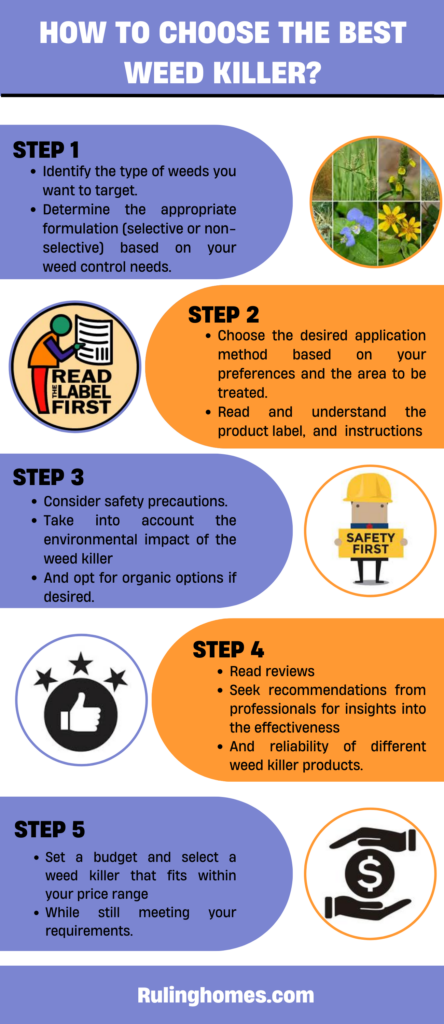Applying weed killers at the right time is crucial for effective weed control.
This step-by-step guide will outline the optimal timing and necessary steps to spray weed killer.
By following these steps, you can maximize the efficacy of the weed killer and promote a healthier, weed-free outdoor space.
Step 1
Before applying weed killer, accurately identify the types of weeds present in your lawn or garden. Different weed killers are formulated to target specific weed species, so knowing the specific weeds will help you choose the appropriate product.
Step 2
Select a weed killer that is suitable for the identified weed species and safe for use in your particular lawn or garden. Read and follow the instructions on the product label carefully, including any precautions or specific application guidelines.
Also Read: Best Weed Killer for Augustin Grass
Step 3
Timing is crucial when it comes to spraying weed killers. Choose a day when the weather conditions are favorable for optimal results. Consider the following factors:
- Temperature: Aim for a temperature range recommended by the weed killer product. Most weed killers work best when applied during specific temperature ranges.
- Wind: Avoid windy days as the wind can cause the weed killer to drift and affect nearby desirable plants or areas.
- Rain: Ensure that rain is not expected for at least 24 to 48 hours after application, as rainfall can wash away the weed killer, reducing its effectiveness.
Step 4
Before spraying weed killer, prepare the area by removing any debris, rocks, or obstacles that may interfere with the application. Mow the lawn or trim the weeds to a suitable height, allowing better contact between the weed killer and the target weeds.
Step 5
Wear protective clothing, including gloves, long sleeves, long pants, closed-toe shoes, and safety goggles, to prevent skin contact and eye irritation. Follow the specific safety recommendations provided on the weed killer product label.
Step 6
Follow the instructions on the product label to mix the weed killer solution accurately. Use a sprayer or applicator recommended for the product and apply the weed killer evenly over the target weeds, taking care to avoid overspray on desirable plants.
Step 7
After applying the weed killer, avoid mowing or disturbing the treated area for at least 24 to 48 hours to allow the product to work effectively. Monitor the treated area for any signs of weed control or re-growth.
How to choose the best weed killer?
Choosing the best weed killer could be difficult as there are so many companies providing the chemicals according to their own understandings. But you need to stick to the below guidelines for choosing the best weed killer.
- Identify the type of weeds you want to target.
- Determine the appropriate formulation (selective or non-selective) based on your weed control needs.
- Choose the desired application method (ready-to-use spray, concentrate, or granular) based on your preferences and the area to be treated.
- Read and understand the product label, including instructions, precautions, and recommended usage.
- Consider safety precautions and ensure you have the necessary protective gear.
- Take into account the environmental impact of the weed killer and opt for environmentally friendly or organic options if desired.
- Read reviews and seek recommendations from gardening experts or professionals for insights into the effectiveness and reliability of different weed-killer products.
- Set a budget and select a weed killer that fits within your price range while still meeting your requirements.
Conclusion
Spraying weed killer can be a powerful tool in controlling and eliminating unwanted weeds in your outdoor spaces.
Proper application techniques and safety precautions will get you to achieve effective weed control while safeguarding the health of desirable plants and the environment.
By following the above guidelines, you can effectively control and eliminate weeds, maintaining a healthier and more aesthetically pleasing outdoor environment.
Remember to prioritize safety, follow the instructions provided, and be mindful of the potential impact on surrounding plants and the environment.

I grew up on a small farm in New Jersey. We had a big family because my parents, my uncles and aunties all were living together on this farm so, you can imagine, it was always over crowded with people. But living in farm was really great because we had to do everything on our own and I learned so many things from my parents and uncles and aunties and that is where I found my passion for fixing things, whether it is renovating or designing, I was always there. Read more

